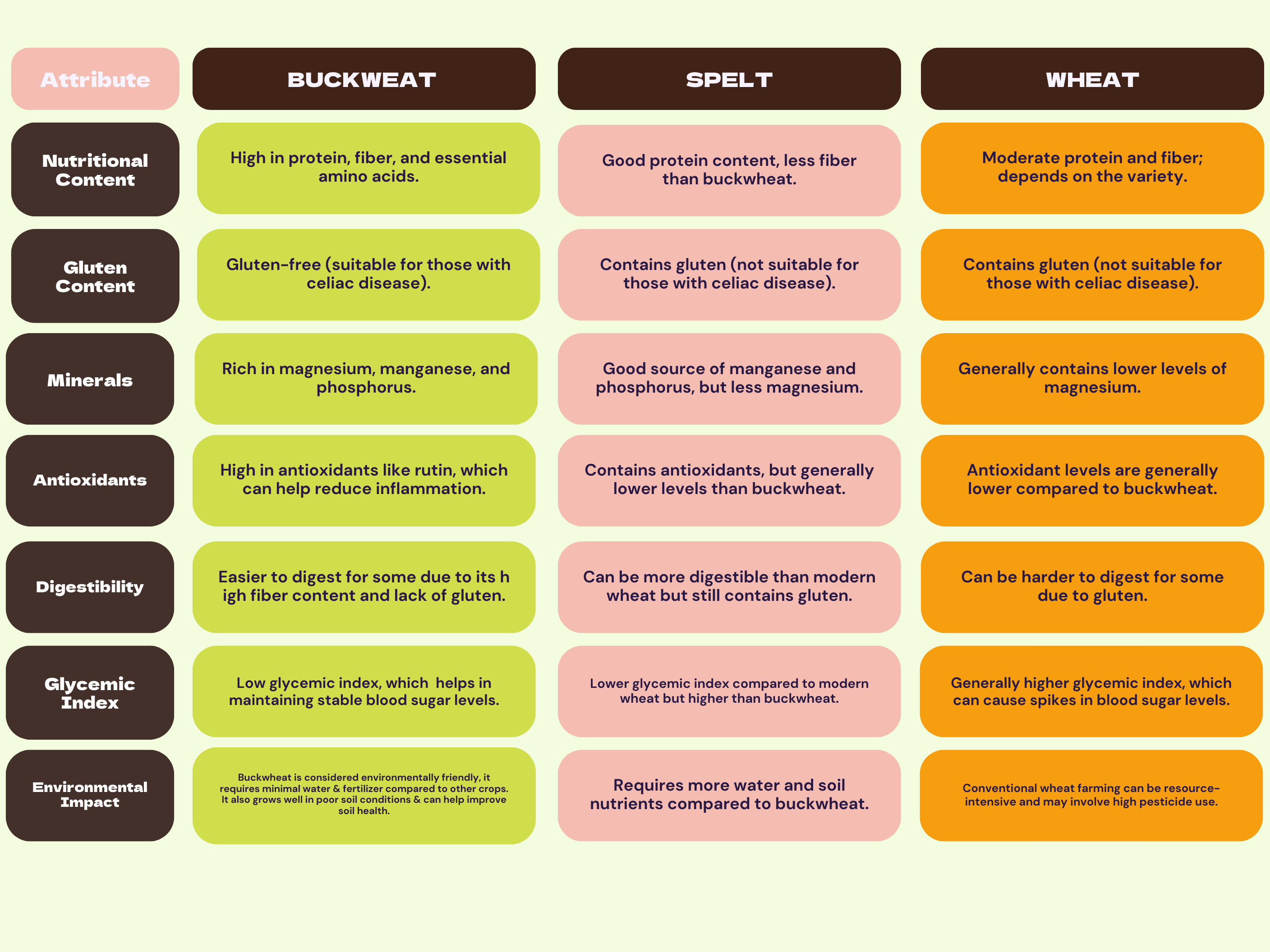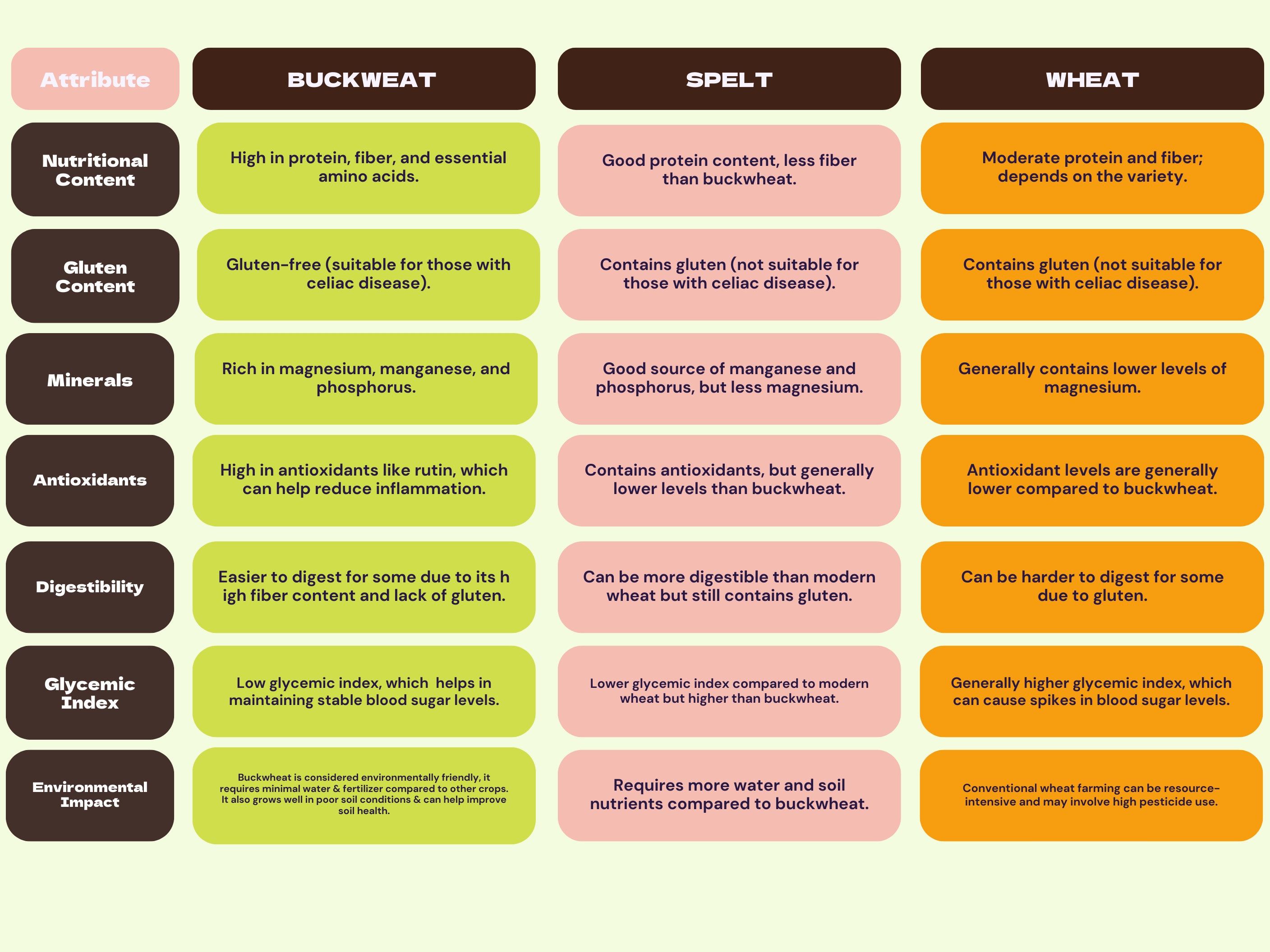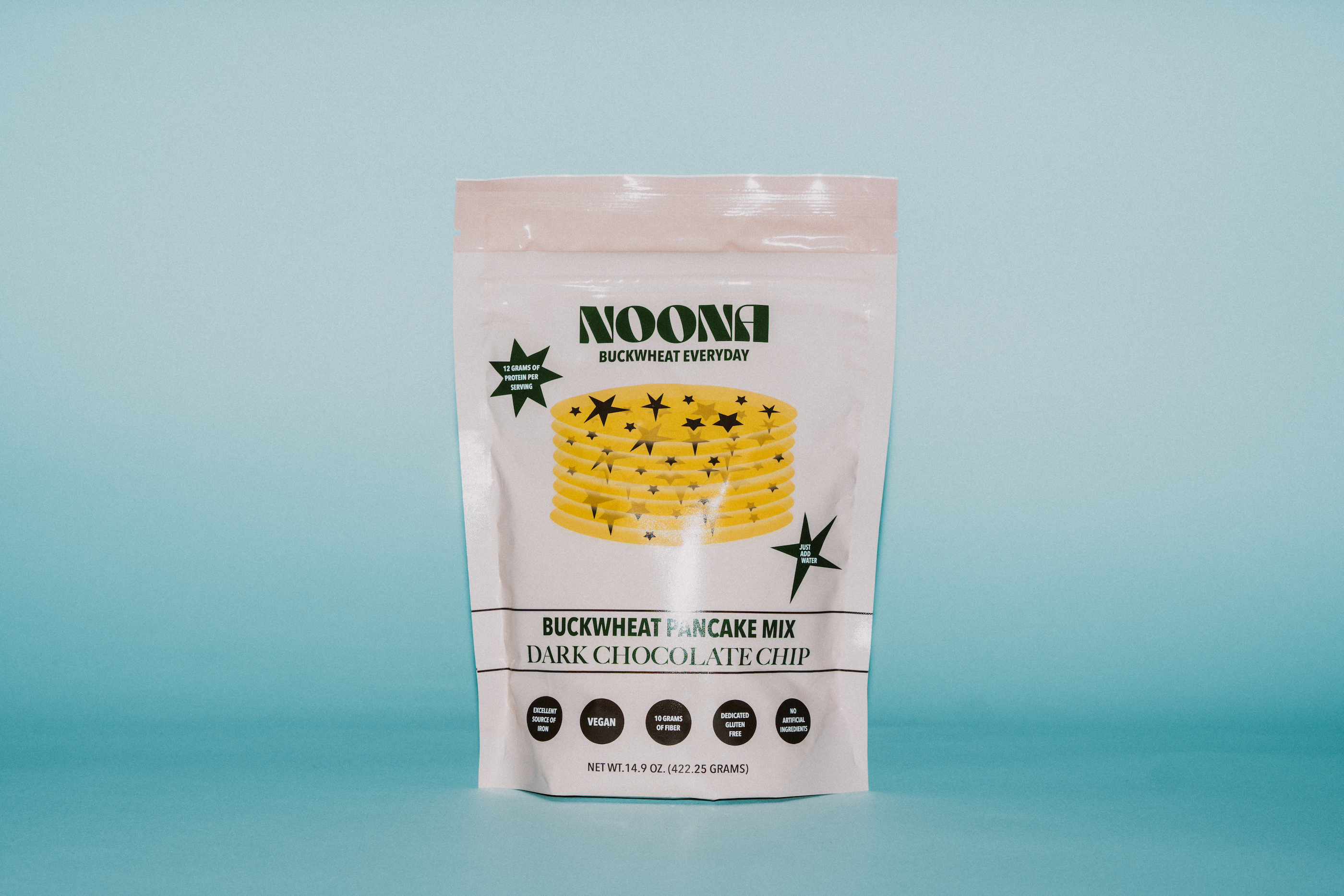

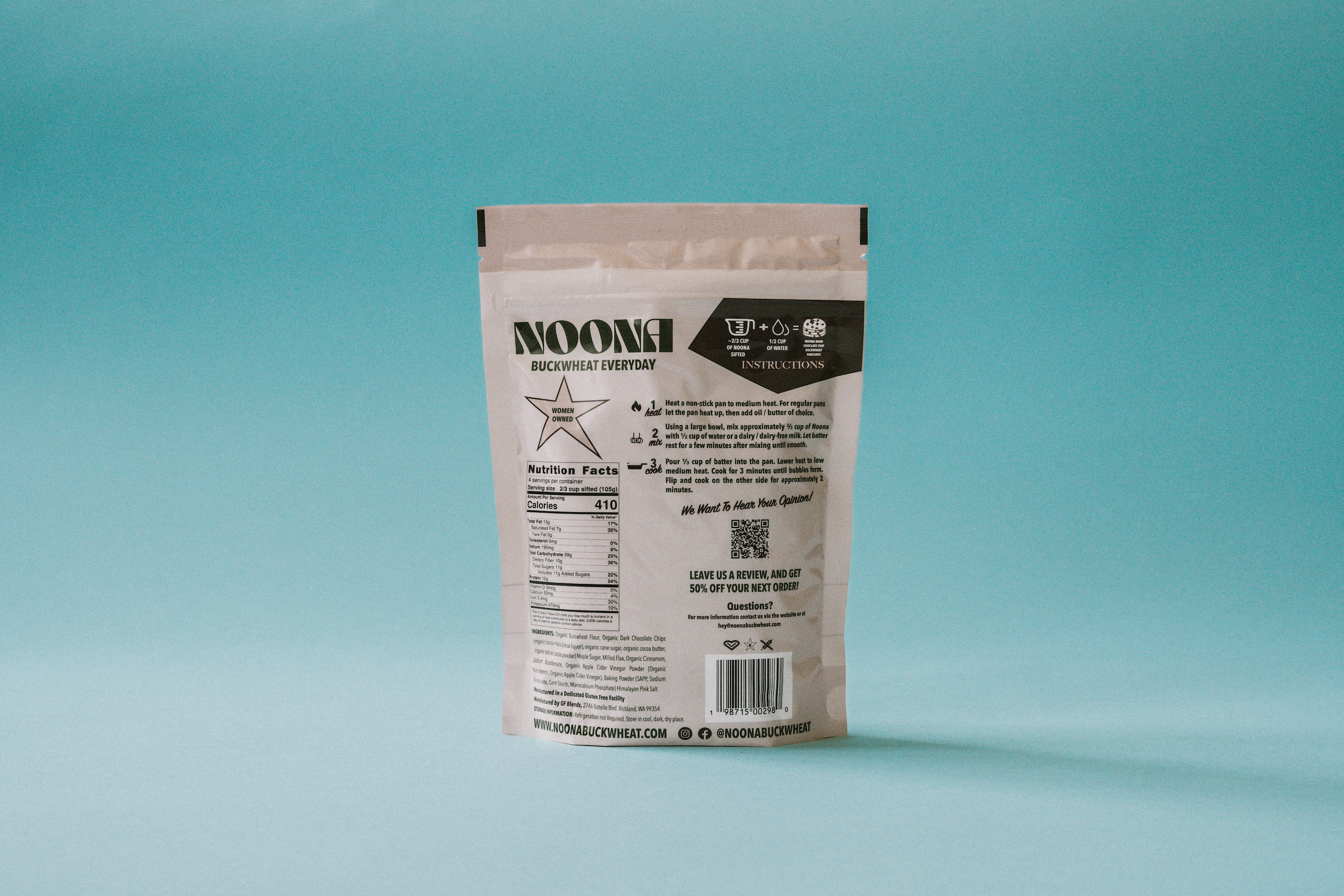
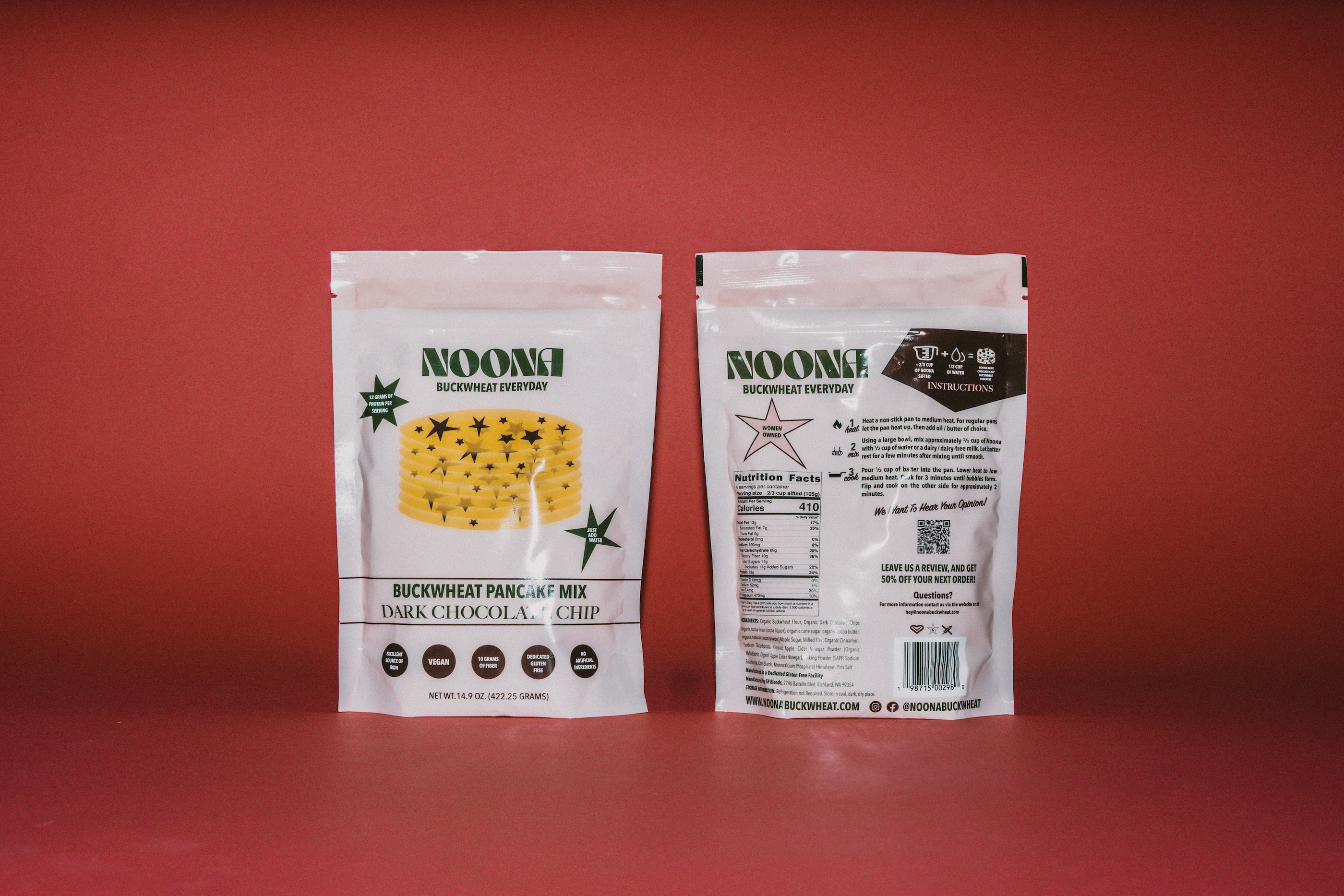
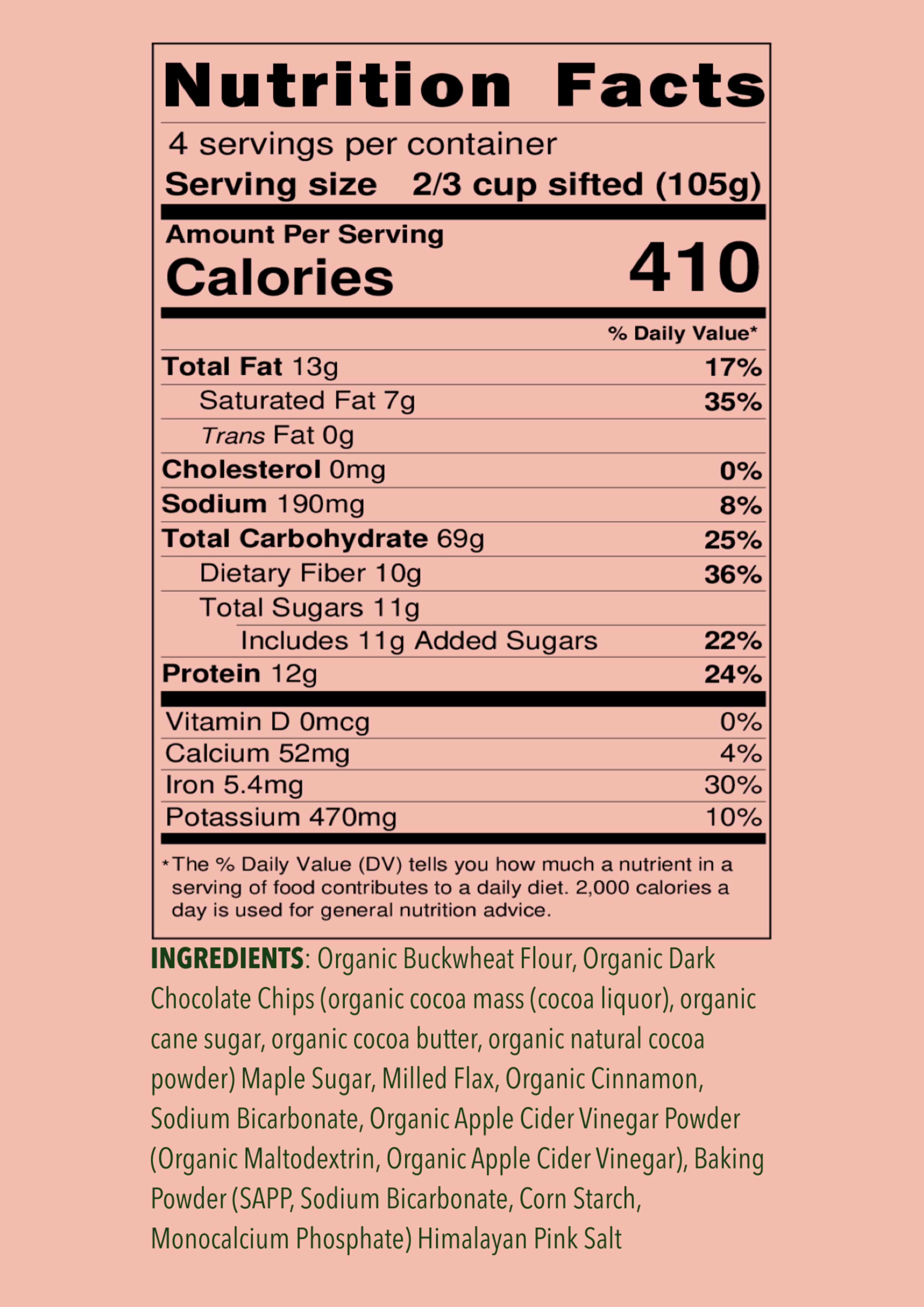
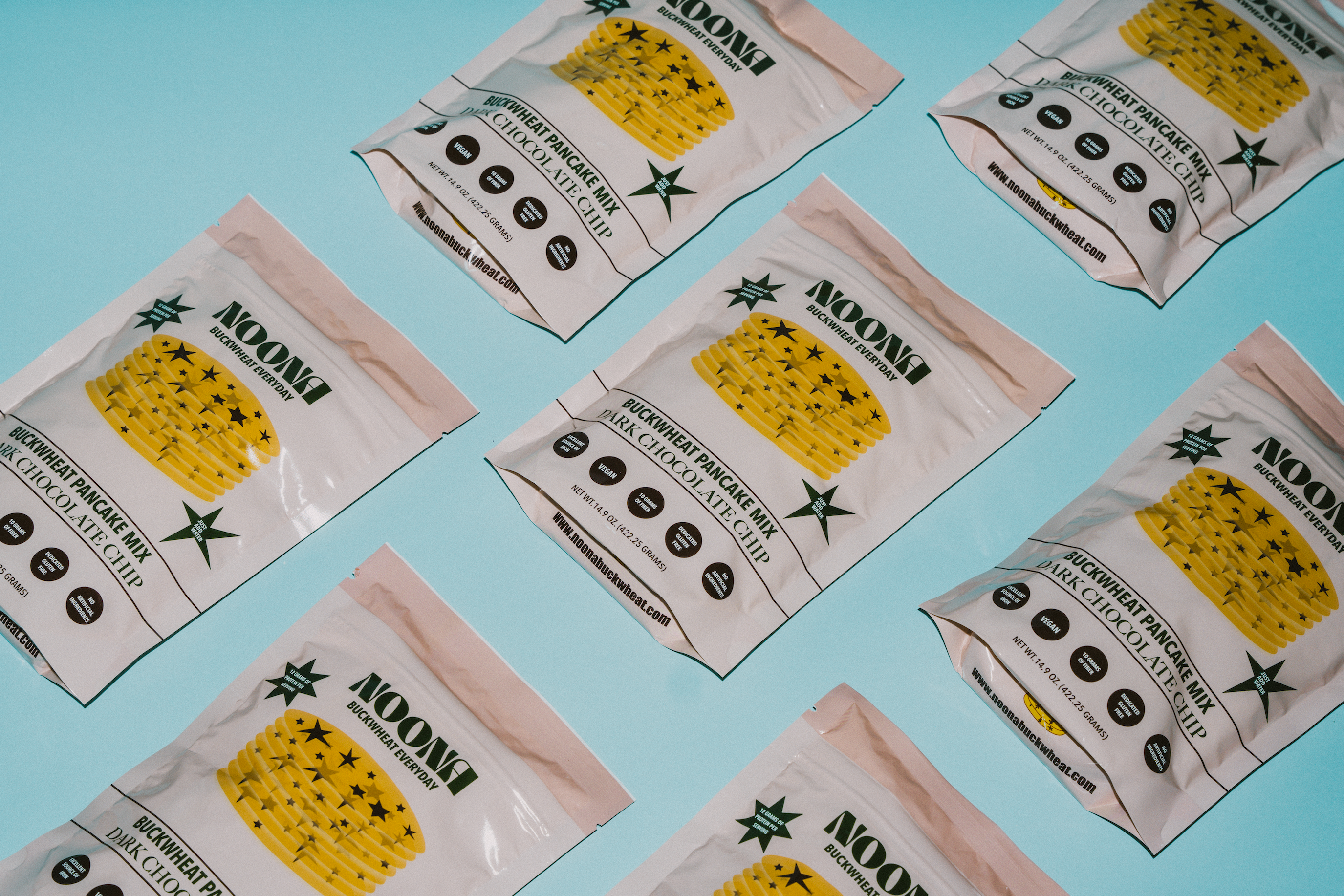
Buckwheat Pancake Mix Dark Chocolate Chip
Fionas Favorite Hot Cakes!!!!
Introducing Our New Dark Chocolate Chip Buckwheat Pancakes!
Why Buckwheat? As someone with IBS, buckwheat has been a game-changer for me. It’s a gluten-free pseudo-grain (actually a seed) that’s perfect for those avoiding wheat. It’s helped me heal and enjoy delicious, wheat-free products.
Why Dark Chocolate Chips? Who doesn’t love chocolate? Dark chocolate adds a delightful sweetness, making these pancakes a tasty and healthier alternative to traditional ones—perfect for everyone, including kids!
Our pancakes are dedicated gluten-free, kosher (star K), vegan, with no artificial flavoring. Check out the health benefits on the website and help us spread the word!
Instructions
(Makes approximately three medium-sized pancakes per serving)
1. Measure the Pancake Mix:
- In a large bowl, add approximately 2/3 cup of Noona's pancake mix.
- Be sure to measure the mix loosely, not packed or dense, for the best consistency.
2. Add Water or Milk:
- Pour in 1/2 cup of water (or dairy/dairy-free milk) into the bowl.
3. Mix the Batter:
- Stir the ingredients together until well combined.
- If the batter feels too thick, slowly add a little more water (or milk), a tablespoon at a time, until the batter reaches a smooth, pourable consistency.
4. Let the Batter Rest:
- Once you reach a good consistency and the batter is smooth with no clumps, let it rest for a few minutes. This helps it thicken and fully develop the flavor.
5. Heat the Pan:
- While the batter rests, heat your pan.
- We recommend using a non-stick pan over medium heat.
- If using a regular pan, heat it first, then add oil or butter of your choice to prevent sticking.
6. Cook the Pancakes:
- Once the pan is ready, pour about 1/3 cup of batter into the pan (makes approximately three pancakes).
- Lower the heat to low-medium.
- Cook for about 3 minutes, or until bubbles start to form on the surface.
7. Flip and Finish Cooking:
- Flip the pancake and cook for another 2 minutes, or until the other side is golden brown.
Viola! Serve hot with your favorite toppings! (Note that these pancakes are made to have a low to mild sweetness so we recommend adding more sweetness to your liking after the pancakes are made i.e. Maple Syrup, Nut Butters etc.)
Ingredient List
Organic Buckwheat Flour, Organic Dark Chocolate Chips (organic cocoa mass (cocoa liquor), organic cane sugar, organic cocoa butter, organic natural cocoa powder) Maple Sugar, Milled Flax, Organic Cinnamon, Sodium Bicarbonate, Organic Apple Cider Vinegar Powder (Organic Maltodextrin, Organic Apple Cider Vinegar), Baking Powder (SAPP, Sodium Bicarbonate, Corn Starch, Monocalcium Phosphate) Himalayan Pink Salt
Key Nutrients
Protein 12g Iron 30%of recommended daily dose Fiber 36% of recommended daily dose Potassium 564mg Calcium 65mg Trans Fat 0g *all per serving

This product is rated 5.0 of 5.0 stars.
It has received 17 reviews.
Our Ingredients
Buckwheat
What is Buckwheat?
Buckwheat, despite its name, is not related to wheat and is actually a seed from the plant Fagopyrum esculentum. It belongs to a group of foods commonly referred to as pseudocereals, which are seeds that are consumed in the same way as grains, though they don’t grow on grasses. Buckwheat is a gluten-free superfood and has been a dietary staple in parts of Asia and Eastern Europe for thousands of years.
Often mistaken for a grain, buckwheat is rich in nutrients and has a nutty, earthy flavor, making it versatile for various culinary uses, including pancakes, noodles, and porridge.
Nutritional Benefits of Buckwheat
- Rich in Essential Nutrients:
Buckwheat is a powerhouse of vitamins and minerals, including magnesium, manganese, copper, iron, phosphorus, and B vitamins, all of which are crucial for supporting overall health. - High in Protein and a Complete Protein Source:
Unlike many plant-based foods, buckwheat contains all nine essential amino acids, making it a complete protein. This is particularly beneficial for vegans and vegetarians seeking plant-based protein sources. - Gluten-Free and Easy to Digest:
Buckwheat is naturally gluten-free, making it an excellent choice for those with celiac disease or gluten sensitivity. It’s also highly digestible and can be enjoyed by people with various digestive issues. - High in Fiber:
With a good amount of dietary fiber, buckwheat supports healthy digestion and can help regulate blood sugar levels. Fiber also plays a role in heart health by reducing cholesterol. - Rich in Antioxidants:
Buckwheat is particularly high in antioxidants like rutin and quercetin. These antioxidants help fight inflammation and reduce oxidative stress, potentially lowering the risk of chronic diseases such as heart disease and certain cancers.
Environmental Benefits of Buckwheat
- Low Impact on Resources:
Buckwheat is an environmentally friendly crop. It grows quickly without the need for chemical fertilizers or pesticides, which makes it a sustainable option for farming. It also thrives in poor soil, needing minimal water, which helps conserve precious resources. - Soil Health & Crop Rotation:
Buckwheat is often used in crop rotation as it helps improve soil structure and fertility. Its fast-growing nature and dense foliage suppress weeds and reduce soil erosion. - Supports Pollinators:
Buckwheat flowers are rich in nectar and attract bees, supporting the health of bee populations and contributing to biodiversity.
Buckwheat is an incredibly nutritious, gluten-free superfood that not only benefits your health but is also great for the environment. At Noona, we use buckwheat as the foundation of our delicious, nutrient-packed Dark Chocolate Chip Buckwheat Pancake Mix to deliver wholesome, clean ingredients you can feel good about.
Sources:
- Healthline: Buckwheat 101: Nutrition Facts and Health Benefits
- Medical News Today: What are the benefits of buckwheat?
- WebMD: Health Benefits of Buckwheat
- Harvard School of Public Health: Whole Grains: Buckwheat
- National Institutes of Health (NIH): The Benefits of Antioxidants
- The Spruce Eats: What Is Buckwheat?
- Food and Agriculture Organization (FAO): Environmental Impact of Crops like Buckwheat
Flaxseed
What is Flaxseed?
Flaxseed, also known as linseed, comes from the flax plant (Linum usitatissimum), one of the oldest cultivated crops in the world. Flaxseed has been prized for its health benefits for thousands of years and is known for its rich nutrient profile, particularly its high content of omega-3 fatty acids, fiber, and antioxidants.
Flaxseed is tiny, golden or brown in color, and has a slightly nutty flavor. It can be consumed in various forms, including whole seeds, ground meal, or flaxseed oil. Often referred to as a "superfood," flaxseed is used in a wide range of recipes, including smoothies, baked goods, and cereals.
Nutritional Benefits of Flaxseed
- Rich in Omega-3 Fatty Acids:
Flaxseed is one of the best plant-based sources of omega-3 fatty acids, specifically alpha-linolenic acid (ALA), which supports heart health by reducing inflammation, lowering blood pressure, and reducing the risk of cardiovascular diseases. - High in Fiber:
Flaxseed is incredibly high in both soluble and insoluble fiber, which aids in digestion, promotes healthy bowel movements, and helps regulate blood sugar levels. Soluble fiber in flaxseed can also reduce cholesterol levels, contributing to heart health. - Excellent Source of Lignans:
Flaxseed is one of the richest dietary sources of lignans, a type of antioxidant with powerful estrogen-like and anti-inflammatory properties. Lignans have been linked to a lower risk of breast cancer, improved heart health, and balanced hormone levels. - Rich in Protein:
Flaxseed contains high-quality plant-based protein, making it a valuable addition to vegetarian and vegan diets. This protein supports muscle repair, growth, and overall body function. - Supports Weight Management:
Due to its fiber content, flaxseed can help you feel full longer, curbing appetite and promoting weight management. It also helps stabilize blood sugar levels, reducing cravings and supporting balanced energy throughout the day.
Health Benefits of Flaxseed
- Heart Health:
The combination of omega-3 fatty acids, fiber, and lignans makes flaxseed a heart-healthy food. Studies show that flaxseed may reduce cholesterol, blood pressure, and the risk of heart disease. - Digestive Health:
The high fiber content in flaxseed promotes regular bowel movements and improves digestive function. It can help prevent constipation and support overall gut health. - Hormone Balance:
The lignans in flaxseed mimic estrogen in the body, which can help balance hormone levels, particularly in women. It may also help alleviate symptoms of menopause and reduce the risk of hormone-related cancers. - Anti-Inflammatory Properties:
The omega-3 fatty acids and lignans in flaxseed help reduce inflammation, which is linked to numerous chronic diseases, including arthritis, asthma, and autoimmune conditions.
Environmental Benefits of Flaxseed
- Sustainable Crop:
Flax is an eco-friendly crop that requires minimal inputs and grows well in various climates. It has a relatively low environmental footprint compared to other oilseed crops like soybeans. - Biodegradable Products:
Beyond its health benefits, flax fibers are also used in the production of biodegradable textiles, paper, and other eco-friendly materials. This makes the flax plant highly versatile, contributing to sustainability in industries beyond food. - Soil Health:
Flax helps improve soil quality and can be used in crop rotation systems to reduce soil erosion and improve biodiversity. It also attracts pollinators, which is essential for a healthy ecosystem.
Flaxseed is a nutrient-dense, plant-based superfood that provides a host of health benefits while also being environmentally sustainable. At Noona, we believe in using the power of flaxseed to create wholesome, nutrient-rich products that fuel your body and support a healthy lifestyle.
Sources:
- Healthline: Flaxseeds 101: Nutrition Facts and Health Benefits
- Medical News Today: What Are the Benefits of Flaxseed?
- Mayo Clinic: Flaxseed: Is Ground Better Than Whole?
- WebMD: Flaxseed: Health Benefits and Nutritional Information
- Harvard School of Public Health: Flaxseeds: Nutrition and Health Benefits
- National Institutes of Health (NIH): The Role of Omega-3 in Flaxseed
Dehydrated Maple Syrup
What is Dehydrated Maple Syrup?
Dehydrated maple syrup is a natural sweetener made by removing the water content from pure maple syrup to create a dry, granulated powder. This process preserves the flavor and nutritional benefits of maple syrup while making it more versatile and shelf-stable for various culinary uses. Dehydrated maple syrup is often used as a replacement for refined sugar in baking, cooking, and beverages, offering the rich, caramel-like flavor of maple syrup in a convenient powdered form.
The process begins by heating pure maple syrup until it reaches a concentrated state. The syrup is then dried, often through methods like spray drying or freeze-drying, to create a fine powder or flakes. This dehydrated form retains much of the original nutrients found in liquid maple syrup but offers longer storage life and ease of use in recipes.
Nutritional Benefits of Dehydrated Maple Syrup
- Retains Antioxidants from Maple Syrup:
Like its liquid form, dehydrated maple syrup contains antioxidants such as phenolic compounds, which help reduce oxidative stress and inflammation in the body. These antioxidants may support the prevention of chronic diseases like heart disease and cancer. - Essential Minerals:
Dehydrated maple syrup retains valuable minerals from pure maple syrup, including zinc, manganese, potassium, and calcium. These minerals contribute to various health benefits, such as supporting immune function, bone health, and energy production. - Lower Glycemic Index Compared to Refined Sugar:
Dehydrated maple syrup has a lower glycemic index than refined white sugar, meaning it causes a slower rise in blood sugar levels. This makes it a more favorable option for people who need to manage blood sugar, though it should still be consumed in moderation. - Less Processed and Natural:
Unlike many sweeteners on the market, dehydrated maple syrup undergoes minimal processing, retaining more of its natural nutrients. It is made without additives or artificial ingredients, offering a cleaner alternative to refined sugars or artificial sweeteners. - Natural Sweetener with Trace Nutrients:
While still a sugar, dehydrated maple syrup provides trace amounts of beneficial nutrients not found in highly processed sweeteners, such as magnesium and riboflavin (Vitamin B2), which are important for metabolism and cellular function.
Health Benefits of Dehydrated Maple Syrup
- Supports Immune Health:
The zinc content in dehydrated maple syrup helps maintain a healthy immune system by supporting cellular function and immune responses. Zinc also plays a role in healing and repairing tissue. - Promotes Bone Health:
Dehydrated maple syrup contains calcium and manganese, both of which are essential for maintaining strong bones and teeth. Manganese also helps in collagen production, which is vital for bone health and skin elasticity. - Supports Heart Health:
The combination of antioxidants and minerals like manganese and zinc found in dehydrated maple syrup helps reduce oxidative stress in blood vessels, contributing to heart health. Regular consumption of foods rich in antioxidants can help lower the risk of heart disease. - Anti-Inflammatory Properties:
The polyphenols found in dehydrated maple syrup have anti-inflammatory effects, which may help reduce inflammation in the body. This can be beneficial for preventing chronic conditions like arthritis and improving overall health.
Environmental Benefits of Dehydrated Maple Syrup
- Sustainable Production:
Dehydrated maple syrup is produced from the sap of sugar maple trees, a renewable resource. The process of tapping trees does not harm the tree, allowing it to continue producing sap for decades. This makes maple syrup, and by extension dehydrated maple syrup, an environmentally friendly sweetener. - Minimal Processing:
The process of making dehydrated maple syrup involves simple dehydration methods, such as spray drying or freeze-drying, that require fewer resources and less energy compared to the production of refined sugars. This minimizes the environmental impact of its production.
Uses for Dehydrated Maple Syrup
Dehydrated maple syrup can be used in a wide variety of applications, offering the natural sweetness and flavor of maple syrup in a dry, easy-to-use form:
- Baking: It can be used as a direct substitute for sugar in baking recipes such as cookies, muffins, and cakes, providing a rich maple flavor while adding a touch of natural sweetness.
- Beverages: It can be dissolved in hot beverages like coffee, tea, or hot chocolate, or used as a sweetener for smoothies.
- Sprinkling on Food: Dehydrated maple syrup can be sprinkled over cereal, oatmeal, yogurt, or fruit for an extra burst of sweetness.
- Dry Rubs and Marinades: Its dry form makes it ideal for incorporating into spice rubs for meat or adding a sweet element to marinades.
Dehydrated maple syrup is a versatile, nutritious alternative to traditional sweeteners, providing the distinctive flavor of maple syrup in a convenient powdered form. At Noona, we are committed to using clean, natural ingredients like dehydrated maple syrup to create products that are both delicious and beneficial for your health.
Sources:
- Healthline: Maple Syrup Nutrition Facts and Health Benefits
- Medical News Today: Is Maple Syrup Good for You?
- WebMD: Maple Syrup: Benefits, Nutrition, and More
- Harvard School of Public Health: Natural Sweeteners: Maple Syrup
- University of Vermont: The Science Behind Maple Syrup
Apple Cider Vinegar
What is Apple Cider Vinegar?
Apple cider vinegar (ACV) is a type of vinegar made from fermented apple juice. The process starts by crushing apples to extract their juice, which is then combined with yeast to ferment the sugars into alcohol. This alcohol is further fermented by acetic acid bacteria, transforming it into vinegar. The final product has a pale to amber color and a strong, tangy flavor, attributed to its high acetic acid content.
ACV has been used for centuries for both culinary and medicinal purposes. It’s a versatile ingredient, often found in salad dressings, marinades, and sauces, while also being used as a natural remedy for various health conditions. ACV is praised for its potential health benefits, which come from its acetic acid, enzymes, and beneficial bacteria.
Nutritional Benefits of Apple Cider Vinegar
- Rich in Acetic Acid:
The main active compound in ACV is acetic acid, which is responsible for many of its health benefits. Acetic acid can help improve digestion, regulate blood sugar levels, and promote fat burning by enhancing metabolism. - Contains Potassium and Trace Minerals:
Apple cider vinegar contains small amounts of potassium, an essential mineral that helps maintain electrolyte balance, supports nerve and muscle function, and regulates blood pressure. ACV also contains trace minerals such as calcium and magnesium, contributing to overall health. - Probiotics and Enzymes:
Unfiltered apple cider vinegar, often referred to as "with the mother," contains beneficial bacteria (probiotics) and enzymes. These probiotics support gut health by promoting the growth of good bacteria in the digestive system, which can improve digestion and immune function. - Low in Calories:
ACV is incredibly low in calories, making it an excellent addition to meals for those looking to reduce caloric intake while still adding flavor. It’s also free of fat, carbohydrates, and protein, providing a tangy flavor without contributing to macronutrient intake.
Health Benefits of Apple Cider Vinegar
- Supports Weight Management:
Some studies suggest that consuming ACV may help with weight loss by promoting satiety and reducing calorie intake. Acetic acid has been shown to suppress appetite and increase fat burning, making ACV a popular supplement in weight management routines. - Helps Regulate Blood Sugar Levels:
ACV is well-known for its potential to improve insulin sensitivity and lower blood sugar levels, particularly after meals. This can be beneficial for individuals with type 2 diabetes or those looking to maintain stable energy levels throughout the day. - Improves Digestion:
The probiotics and enzymes in raw, unfiltered ACV can promote healthy digestion. It may help with bloating, indigestion, and heartburn by stimulating stomach acid production, which aids in breaking down food more effectively. - Antimicrobial Properties:
ACV has natural antimicrobial properties, making it effective for killing harmful bacteria. It’s often used as a natural disinfectant and preservative. Historically, ACV was used for cleaning wounds and treating infections due to its ability to kill pathogens. - May Improve Heart Health:
Some studies have shown that ACV may help lower cholesterol levels and blood pressure, both of which are important factors for maintaining heart health. The potassium and antioxidants in ACV may also contribute to a healthy cardiovascular system.
Environmental Benefits of Apple Cider Vinegar
- Made from Natural, Renewable Resources:
Apple cider vinegar is made from apples, a renewable resource, making it an environmentally friendly product. The production process is relatively simple and does not require synthetic chemicals or excessive resources, making it a sustainable option compared to heavily processed products. - Biodegradable and Non-Toxic:
ACV is completely biodegradable and non-toxic, which makes it a safe choice for cleaning and other household uses. When used as a cleaner, it does not introduce harmful chemicals into the environment, making it a greener alternative to conventional cleaning agents.
Uses for Apple Cider Vinegar
Apple cider vinegar is incredibly versatile and can be used in a variety of ways:
- Culinary Uses:
- Health and Wellness:
- Natural Cleaning Solution:
- Beauty and Skin Care:
Apple cider vinegar is a time-honored natural remedy that offers numerous health, wellness, and environmental benefits. At Noona, we believe in using natural, wholesome ingredients like apple cider vinegar to promote a healthy lifestyle and support sustainable living.
Sources:
- Healthline: Apple Cider Vinegar: Benefits, Uses, and Dosage
- Medical News Today: Apple Cider Vinegar: Benefits, Uses, and Side Effects
- WebMD: Apple Cider Vinegar: Uses and Health Benefits
- Harvard School of Public Health: Apple Cider Vinegar: Benefits and Myths
- National Institutes of Health (NIH): Health Benefits of Apple Cider Vinegar
Himalayan Pink Salt
What is Himalayan Pink Salt?
Himalayan pink salt is a naturally occurring rock salt harvested from the ancient salt mines located in the foothills of the Himalayas, primarily in the Punjab region of Pakistan. Known for its distinct pink hue, Himalayan salt gets its color from trace minerals like iron, potassium, magnesium, and calcium, which contribute to both its appearance and health benefits.
Unlike heavily processed table salt, Himalayan pink salt is often less refined and contains a variety of minerals not present in other salts. It's prized for its purity and is believed to be one of the most ancient forms of salt, originating from the evaporation of ancient seas millions of years ago. This makes it a sought-after ingredient in both culinary and wellness applications.
Nutritional Benefits of Himalayan Pink Salt
- Rich in Essential Minerals:
Himalayan pink salt contains more than 80 trace minerals and elements, including magnesium, calcium, and potassium. These minerals play important roles in many bodily functions, including maintaining electrolyte balance, supporting bone health, and promoting proper muscle function. - Lower Sodium Content Compared to Table Salt:
While Himalayan pink salt still contains sodium, its larger, unrefined crystals mean that it has less sodium by volume compared to processed table salt. This makes it a slightly healthier option for seasoning food without overloading on sodium. - Contains Iron:
The pink color of Himalayan salt is due to its iron content, which can help boost iron levels when consumed in moderation. Iron is an essential mineral that aids in red blood cell production and the transport of oxygen throughout the body. - Naturally Unrefined:
Unlike table salt, which is often processed and stripped of minerals, Himalayan pink salt is typically unrefined, retaining its natural mineral content. It is also free of additives like anti-caking agents and iodine, which are commonly added to table salt.
Health Benefits of Himalayan Pink Salt
- Supports Hydration:
Himalayan pink salt helps regulate the body's hydration levels by maintaining the balance of electrolytes. The minerals in Himalayan salt, including potassium and magnesium, play a role in water retention and cellular function, making it a good option for replenishing lost electrolytes after physical activity. - Improves Digestion:
Pink salt can stimulate the production of stomach acid, aiding digestion and nutrient absorption. It’s sometimes used in home remedies to relieve indigestion, bloating, and heartburn by promoting healthy stomach acid levels. - Balances pH Levels:
Himalayan pink salt can help maintain the body’s pH balance by promoting alkalinity. This can reduce the risk of inflammation and other health issues that stem from excess acidity in the body, such as arthritis or metabolic acidosis. - Supports Respiratory Health:
Salt therapy, also known as halotherapy, involves inhaling air infused with salt particles and has been shown to improve respiratory conditions such as asthma, allergies, and bronchitis. Himalayan pink salt is often used in salt lamps and inhalers to promote better breathing by helping to clear mucus and reduce inflammation in the airways. - Detoxification and Skin Health:
Himalayan pink salt is frequently used in baths and scrubs for its detoxifying properties. When dissolved in warm water, it can help draw out toxins from the skin, reduce inflammation, and promote relaxation. It is also used in exfoliating scrubs to remove dead skin cells and improve skin texture.
Environmental Benefits of Himalayan Pink Salt
- Naturally Harvested and Renewable:
Himalayan pink salt is harvested by hand from ancient salt mines, making it a natural and renewable resource. The mining process is relatively low-impact compared to other salt extraction methods, and the salt itself is free of synthetic additives or processing. - Sustainability:
Since Himalayan pink salt is harvested from naturally occurring deposits formed millions of years ago, it doesn’t rely on modern, resource-intensive methods like chemical processing or artificial evaporation. This makes it a more sustainable choice compared to highly processed salts. - Biodegradable and Non-Toxic:
Himalayan pink salt is completely biodegradable and non-toxic, meaning it can be safely used for purposes like home cleaning, personal care, or wellness practices without introducing harmful chemicals into the environment.
Uses for Himalayan Pink Salt
Himalayan pink salt is a versatile product with numerous applications:
Culinary Uses:
Seasoning: It’s used as a flavorful alternative to table salt for seasoning dishes, grilling, roasting, or even finishing delicate foods.
Salt Blocks: Himalayan pink salt is often sold in the form of large blocks, which can be heated and used for cooking meats, seafood, and vegetables, imparting a unique flavor.
Brining and Pickling: Its mineral-rich profile makes it a great choice for brining meats or pickling vegetables.
Himalayan pink salt is not only a flavorful, mineral-rich alternative to table salt, but it also offers numerous health and wellness benefits. At Noona, we believe in using pure, natural ingredients like Himalayan pink salt to promote a healthy, balanced lifestyle, whether it's in the kitchen or in your self-care routine.
Sources:
- Healthline: Himalayan Pink Salt: Is It Good for You?
- Medical News Today: Himalayan Salt vs. Sea Salt: What's the Difference?
- WebMD: The Health Benefits of Himalayan Salt
- Harvard School of Public Health: Salt and Sodium: Nutrition and Health
- National Institutes of Health (NIH): Mineral Content of Himalayan Salt
Dark Chocolate Chips
What are Dark Chocolate Chips?
Dark chocolate chips are small, bite-sized pieces of chocolate made from cocoa solids, cocoa butter, and sugar. Unlike milk chocolate, dark chocolate chips contain little to no milk solids, resulting in a more intense, rich chocolate flavor with a slightly bitter edge. The percentage of cocoa in dark chocolate chips typically ranges from 50% to 85%, with higher percentages indicating a stronger chocolate flavor and less sugar content.
Dark chocolate chips are widely used in baking and desserts, as their small size allows them to melt evenly and provide bursts of chocolate flavor in cookies, muffins, pancakes, and more. In addition to their delicious taste, dark chocolate chips offer a range of health benefits due to their high cocoa content.
Nutritional Benefits of Dark Chocolate Chips
- Rich in Antioxidants:
Dark chocolate chips are loaded with powerful antioxidants, particularly flavonoids, which can help reduce inflammation and fight oxidative stress in the body. These antioxidants have been linked to improved heart health and may help reduce the risk of chronic diseases. - High in Iron, Magnesium, and Zinc:
Dark chocolate is a good source of several essential minerals, including iron, magnesium, and zinc. Iron supports the production of red blood cells, magnesium plays a role in muscle and nerve function, and zinc supports immune health. - Low in Sugar (Compared to Milk Chocolate):
Dark chocolate chips contain significantly less sugar than milk chocolate chips, especially when they have a higher percentage of cocoa. This makes them a healthier option for those looking to limit their sugar intake while still enjoying a sweet treat. - Healthy Fats:
The cocoa butter in dark chocolate chips contains healthy fats, such as monounsaturated fats and stearic acid, which may help improve cholesterol levels. These fats can support heart health by reducing "bad" LDL cholesterol and promoting "good" HDL cholesterol. - Rich in Fiber:
Dark chocolate chips contain a decent amount of fiber, which can support digestive health and help regulate blood sugar levels. Fiber also promotes a feeling of fullness, making dark chocolate chips a more satisfying treat.
Health Benefits of Dark Chocolate Chips
- Improves Heart Health:
The flavonoids in dark chocolate chips help promote heart health by improving blood flow, reducing blood pressure, and lowering cholesterol levels. Studies have shown that consuming moderate amounts of dark chocolate may reduce the risk of heart disease. - Boosts Brain Function:
Dark chocolate chips contain compounds that may boost brain function. The flavonoids in cocoa improve blood flow to the brain, potentially enhancing cognitive function, memory, and focus. Dark chocolate also contains small amounts of caffeine and theobromine, both of which have mild stimulant effects. - Supports Mood and Mental Health:
Eating dark chocolate chips can trigger the release of endorphins and serotonin, both of which promote feelings of happiness and relaxation. Dark chocolate also contains phenylethylamine (PEA), a compound that can elevate mood and improve mental well-being. - Helps Regulate Blood Sugar:
Dark chocolate chips, particularly those with a higher cocoa content, have a lower glycemic index, meaning they cause a slower, more gradual rise in blood sugar levels compared to sugary snacks. This can help prevent blood sugar spikes and crashes, making dark chocolate a better option for individuals with diabetes or those monitoring their blood sugar levels. - Supports Skin Health:
The antioxidants in dark chocolate chips, particularly flavonoids, can protect the skin from damage caused by UV rays and improve skin hydration and elasticity. Some studies suggest that regularly consuming dark chocolate can help maintain healthy, youthful-looking skin.
Environmental Benefits of Dark Chocolate Chips
- Sustainably Sourced Cocoa:
Many dark chocolate chips are made from cocoa that is sustainably sourced. Ethical brands work with cocoa farmers who use eco-friendly farming practices, such as organic farming, which helps protect the environment by reducing pesticide use and promoting biodiversity. - Fair Trade Practices:
Purchasing fair-trade dark chocolate chips ensures that cocoa farmers receive fair wages and work under humane conditions. Supporting fair trade also encourages environmentally sustainable farming practices and helps combat child labor in the cocoa industry. - Reduced Environmental Impact:
Dark chocolate typically has a lower environmental impact than milk chocolate, as it requires fewer resources like milk and sugar. By choosing dark chocolate chips, consumers can support a more eco-friendly option in the chocolate industry.
Uses for Dark Chocolate Chips
Dark chocolate chips are versatile and can be used in a variety of culinary and wellness applications:
Sources:
- Healthline: Dark Chocolate: Benefits, Nutrition, and More
- Medical News Today: What Are the Benefits of Dark Chocolate?
- WebMD: Dark Chocolate: Health Benefits and Nutrition
- Harvard School of Public Health: Chocolate: Pros and Cons of This Sweet Treat
- National Institutes of Health (NIH): Cocoa and Cardiovascular Health

